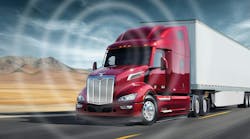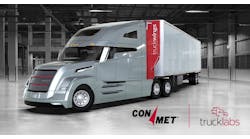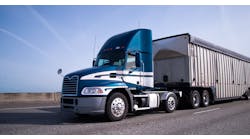In the last 20 years, truck diagnostics have evolved in many ways for both fleets and manufacturers. While diagnostics were once primarily a reactive tactic, now they’re able to provide real-time visibility into a vehicle’s health and even help catch problems before they occur.
“Diagnostics were once primarily done after a problem occurred and the truck was at a shop,” said Patrick Brown, Mack senior strategy and sustainability manager. “However, there was very little information about how and when an issue occurred, what the truck was doing, and what else was happening at the time of the failure. With the advent of monitoring services like GuardDog Connect, diagnostics began to incorporate real-time information, allowing a better understanding of the root cause of a failure.”
The industry also needs to have a more clear understanding of existing truck, tractor, and trailer telematics and remote diagnostic capabilities. With the help of OEM developers and fleet customers, we have compiled a brief overview of those capabilties below.
The evolution of diagnostics
Diagnostics once may not have been able to identify specifics of a given problem with a truck, but the technology’s growing processing capabilities now offer fleets more details and greater accuracy when detecting faults. What's more, they can now work with other systems such as AI, machine learning, and predictive models.
Remote diagnostics monitoring plays a large role in this by offering more actionable, recent insights on a vehicle’s condition at any given moment, granting fleets immediate data to make decisions about their trucks, explained Patrick Wallace, Peterbilt marketing manager for zero-emission and connected trucks.
“Diagnostics have become more convenient and accessible for fleets and dealers to get actionable information,” Wallace noted. “With Peterbilt's SmartLINQ line of connected services, we offer remote diagnostics for engines and aftertreatment systems that feature fault codes and historical sensor data. That information is helpful to fleet managers and technicians as it speeds up intake at repair facilities and increases uptime.”
Additionally, diagnostics can now meet the needs of more specific commercial vehicle applications, such as the cold chain.
“For example, real-time alerts and exception-based reporting take on added significance for reefer fleets,” said Scott Blair, Lynx Fleet Telematics senior digital program manager, Carrier Transicold Truck/Trailer/Rail Americas. “Operations and maintenance managers want to be notified automatically when something happens that can affect conditions inside the vehicle, such as deviation from temperature setpoints or a low battery or fuel level.”
As a result of these changes, fleets and their maintenance departments are more efficient and have greater control over their work.
“By understanding how trucks operate, fleets can compare specs and make data-driven decisions,” said Magnus Gustafson, Volvo Trucks North America VP of connected services. “Having that insight and visibility also helps control operations, remotely set and program-specific operating parameters, and provide fleet managers with a means to control costs and adjust to external factors such as fuel prices.”
All of these contribute to labor savings by helping technicians spend their time wisely and have easy access to the information they need without needing to comb through too much aftermarket hardware on a truck.
Remote diagnostics and maintenance plans
With remote diagnostics acting as essential stepping stones to predictive technologies, fleets can see the patterns contributing to recurring vehicle issues, allowing fleets to build predictive data models, Wallace said.
Diagnostic data can provide historical data points that identify trends over time with specific model years and makes of equipment, agreed Alex Clementi, pre-sales engineer at Decisiv. With that information, he added, you can make better decisions and adjustments to maintenance plans.
Onboard telematics devices have enabled fleets to pair their diagnostic tools with remote diagnostic applications for around-the-clock monitoring of their entire fleet, according to Jason Hedman, product manager at Noregon. "Remote diagnostics offer the obvious benefits of monitoring vehicles while on the road, but additional uses exist, such as easing the pre-trip inspection process.
"Rather than walk around the yard and connect a diagnostic tool to each tractor to ensure it is road ready, fleets can use applications like TripVision to create geofences around their facilities and view the health, safety, and performance status of each asset," Hedman explained. "Additionally, fleets can use the same geofences and create alerts if a vehicle leaves the facility with a health or safety issue."
"Historical data is also a key piece of the puzzle in diagnosing recurring issues," Hedman added. "Our JPRO diagnostic tool includes a Fault History feature that allows technicians to view the faults from previous JPRO connections on that asset."
For fleets and service providers, automating the process of receiving diagnostic data is a game changer, noted Clementi. "Across different telematics providers and systems, and fleet and asset management solutions, including the Decisiv SRM platform, you now have information sent to you instead of having to access that data or keep track of it on your own," he said. "Those tools and technology are the key to reducing and preventing unplanned, unscheduled downtime."
Remote diagnostics and electric vehicles
This ability to leverage remote diagnostics to inform maintenance planning is even more important with the advent of alternatively powered trucks, such as electric vehicles.
"Remote diagnostics are very important with EVs," said Peterbilt’s Wallace noted. "Where EVs differ is that they are very efficient vehicles that must do a lot of work with a small amount of energy."
"Weather and things like auxiliary usage state of charge can greatly affect the range of an electric truck," he continued. "That means fleet managers need to be empowered to watch their energy usage for route planning and optimization, so those are important remote diagnostic features we are planning to add with our future EV product releases."
Brown considers EV monitoring essential. "Through remote monitoring, we will be able to help our customers get the best performance out of their EVs."
"With telematics on EVs, we can understand usage behaviors, patterns, and specific applications and provide recommendations to help extend battery life and ensure batteries are optimized to operate at peak performance," said Volvo's Gustafson. "Our customers are still learning how to best operate these new vehicles, so by aggregating data to identify trends, patterns, and outliers, we can consult with fleets to make best-practice recommendations."
This article was curated from FleetOwner.com.




